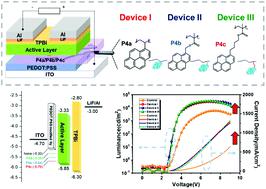当前位置:
X-MOL 学术
›
Mater. Chem. Front.
›
论文详情
Our official English website, www.x-mol.net, welcomes your
feedback! (Note: you will need to create a separate account there.)
Improving the performance of all-inorganic perovskite light-emitting diodes through using polymeric interlayers with a pendant design
Materials Chemistry Frontiers ( IF 6.0 ) Pub Date : 2021-08-11 , DOI: 10.1039/d1qm01027a Chiung-Han Chen, Yan-Cheng Lin, Yun-Fang Yang, Yun-Chi Chiang, Zhenchao Li, Hin-Lap Yip, Wen-Chang Chen, Chu-Chen Chueh
Materials Chemistry Frontiers ( IF 6.0 ) Pub Date : 2021-08-11 , DOI: 10.1039/d1qm01027a Chiung-Han Chen, Yan-Cheng Lin, Yun-Fang Yang, Yun-Chi Chiang, Zhenchao Li, Hin-Lap Yip, Wen-Chang Chen, Chu-Chen Chueh

|
Despite demonstrating higher photoluminescence quantum yield and better ambient and operational stability than organic–inorganic hybrid perovskites, all-inorganic perovskites encounter the problem of inferior film quality and interfacial electrical properties, which limits the resultant device performance. In this study, three polymers, P4a–c, bearing distinct pendant groups based on a similar conjugated group are synthesized and employed as an interlayer to modify the PEDOT:PSS/CsPbBr3 interface. Due to the pendant design, P4a–c possess deep-lying HOMO levels and high transparency across the visible range. The different structures of the pendant groups in P4a–c are shown to result in their different propensity in energy-level modulation and solid-state aggregation, which plays a non-trivial role in affecting the resulting device performance. Due to the more appropriate energy levels and better regulation of CsPbBr3 crystals, P4c with a polar bridge moiety is shown to better mediate the performance of the derived device. The P4c-mediated PeLED delivers six times enhanced luminance (Lmax, ∼36 000 cd m−2) and 3.6 times enhanced external quantum efficiency (EQE, 2.16%) as compared to the control device (∼6000 cd m−2, 0.60%). Notably, all the devices using P4a–c interlayers deliver a lower turn-on voltage than the control device, clearly revealing the positive role of P4a–c interlayers on diminishing the barrier across the associated interface to improve charge injection efficiency.
中文翻译:

通过使用带有悬垂设计的聚合物夹层提高全无机钙钛矿发光二极管的性能
尽管比有机-无机杂化钙钛矿表现出更高的光致发光量子产率以及更好的环境和操作稳定性,但全无机钙钛矿遇到了薄膜质量和界面电学性能差的问题,这限制了所得器件的性能。在这项研究中,合成了三种聚合物,P4a-c,基于相似的共轭基团带有不同的侧基,并将其用作中间层来修饰 PEDOT:PSS/CsPbBr 3界面。由于吊坠设计,P4a-c在可见光范围内具有深层的 HOMO 能级和高透明度。P4a-c 中侧基的不同结构显示出它们在能级调制和固态聚集方面的不同倾向,这在影响最终设备性能方面起着重要作用。由于更合适的能级和对 CsPbBr 3晶体的更好调节,显示具有极性桥部分的P4c可以更好地调节衍生器件的性能。所述P4C介导的递送佩莱德六次增强亮度(大号最大值,〜36 000 CD米-2)和3.6倍增强的外量子效率(EQE,2.16%)相比,控制装置,(~6000 CD米-2,0.60 %)。值得注意的是,所有使用P4a–c的设备夹层提供比控制器件更低的开启电压,清楚地揭示了P4a-c夹层在减少相关界面上的势垒以提高电荷注入效率方面的积极作用。
更新日期:2021-08-27
中文翻译:

通过使用带有悬垂设计的聚合物夹层提高全无机钙钛矿发光二极管的性能
尽管比有机-无机杂化钙钛矿表现出更高的光致发光量子产率以及更好的环境和操作稳定性,但全无机钙钛矿遇到了薄膜质量和界面电学性能差的问题,这限制了所得器件的性能。在这项研究中,合成了三种聚合物,P4a-c,基于相似的共轭基团带有不同的侧基,并将其用作中间层来修饰 PEDOT:PSS/CsPbBr 3界面。由于吊坠设计,P4a-c在可见光范围内具有深层的 HOMO 能级和高透明度。P4a-c 中侧基的不同结构显示出它们在能级调制和固态聚集方面的不同倾向,这在影响最终设备性能方面起着重要作用。由于更合适的能级和对 CsPbBr 3晶体的更好调节,显示具有极性桥部分的P4c可以更好地调节衍生器件的性能。所述P4C介导的递送佩莱德六次增强亮度(大号最大值,〜36 000 CD米-2)和3.6倍增强的外量子效率(EQE,2.16%)相比,控制装置,(~6000 CD米-2,0.60 %)。值得注意的是,所有使用P4a–c的设备夹层提供比控制器件更低的开启电压,清楚地揭示了P4a-c夹层在减少相关界面上的势垒以提高电荷注入效率方面的积极作用。










































 京公网安备 11010802027423号
京公网安备 11010802027423号